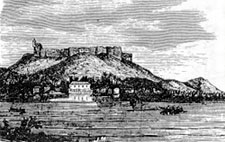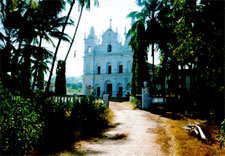
| Dedication |
|
|
| Preface |
|
|
| Contents |
|
|
| Personal
Tributes to Pascoal |
|
|
| Family Trees |
|
|
| About the Author |
|
|
| Home |
|
ANJUNA AT THE TURN OF THE CENTURY Even as far back in time, as the turn of the last century, Anjuna was an enchanting place. Nestled in a green valley, bordered by a wide stretch of sandy beach and tall coconut palms swaying to the gentle breezes of the Arabian Sea. This sleepy Konkan hamlet within the district of Bardez, in Goa, was indeed a haven of peace. It was still virgin - untouched! Its charm was a secret shared by its inhabitants alone. For who else came to Anjuna then? Chapora The port of
Chapora had for long been a vital maritime hub. In Muslim times it
was a gateway to the holy city of Mecca, and many ships were
anchored, repaired and even built there. To Chapora came Arab dhows
loaded with horses bound for the great market at Pernem, across the
creek. These noble steeds were in constant demand for supply to
cavalry regiments of the south.
Much traffic still continued. And, moreover, while its prestige as a military outpost declined, the fortress of Chapora became better known as a major Customs check-post and a thriving fishing-station. In 1860 a building in the vicinity, which had taken three years to build, was completed and occupied as his residence by the Portuguese Commandant. It served also as a sort of local post-office. We are even told of a bastion having been installed in 1872, with five canons directed at Morjim across the bay. But within twenty years that bastion had been dismantled and the canons disarmed. The fortress became just a paper tiger; for no longer did any dangerous enemy lurk. Already, with the entry of other Europeans into the Orient, Portugal was shorn of the trade monopoly she had enjoyed. After repeatedly encountering several military and naval reverses, her maritime empire faced the threat of extinction. Economic conditions in Goa, the capital, steadily deteriorated. The authorities entered into the Anglo-Portuguese Treaty of 1878. This brought about far-reaching change - but not to their economy! It opened the way to rail and steamship communication with the hinterland via the port of Mormugao. However, since neither dredging nor pilot facilities were undertaken to ensure the safe entry of big steamships into the port of Chapora, it soon dwindled even as a fishing-station. But by no means was it idle. A major fall-out of the Treaty was the incentive it gave to smuggling. A few enterprising people of the village amassed fortunes during this heyday. In fact smuggling, even in opium, became a major activity in Chapora. A most lucrative trade connection with Daman was established by one Caetano Diogenes Mascarenhas of Mazalvaddo, a ward of Anjuna. Popularly known as "Caetano Coco", he exported coconuts, rice and other local commodities from his vast ancestral property via the port of Chapora. For services rendered during a famine, in 1900 the Portuguese Government conferred on him the title of Visconde de Daman. In 1892 Colaco de Souza, nicknamed "Conde", set up a thriving saw-mill and wood depot near the Customs House. Another who succeeded in the same line was Cyprian Valles of Vagator; he despatched his goods out of Goa in pattimars, and down the river in small catamarans. Other celebrities There were a few from Anjuna who were carving a niche in the academic sphere. Brilliant as lawyers, in Goa, were Manoel Jose de Abreu and Caetano Mariano Vaz; and in British India, Hermengildo Marcus Antonio Drago. At the dawn of this century Dr. Manuel Albuquerque distinguished himself in Zanzibar, and the gifted writer Julio Marcelo Campos did likewise in Kenya. There were of course several "barcars" or landed proprietors: the families of da Gama Pinto, Mascarenhas, Abreo and Rodrigues who dwelt in grand mansions spread out mostly in the vicinity of the church. They lived in ease on the profits from the produce of their vast estates, lording it over their less-fortunate "mundkars" or tenants, who were largely under their control. St.
Michael's Church
Schools Barring the parish school and some classes of dogmatic teaching, Anjuna like most other villages of Goa had no semblance of a regular recognised institution for public learning until the last decade of the century gone by. In 1889 the Escola Regia was instituted in Anjuna with just 18 pupils. The following year it initiated the Escola Primaria which grew in strength and flourished until Liberation. Alongside it, several small nursery and primary classes were conducted by private individuals in various sectors of the village. A few of these elementary institutions evolved, during this century, into the English-teaching High Schools of the village today. Vaddos Anjuna was divided for administrative purpose into 13 "bairros" or wards: Ganvaddi, Mazalvaddo, St.Miguel, Prias, Soranto, Murmota, Rautovaddo, Gumalvaddo, Vagator, Chapora, Chinvar Grande, Chinvar Pequeno, Kumbharvaddo. Like most villages in the province, Anjuna was self-sufficient. And from the earliest times, like its counterparts, it had its specific habitats for occupational groups. At the"shimner" or border converging on the neighbouring village of Arpora was "foger vaddo" where dwelt the "porobs" who made fire-crackers and explosives - a vital requisite at festivals! Not far off was "sonar vaddo" - another slice of the village, inhabited by the traditional "sonars" or goldsmiths who turned out exquisite jewelry. Close by was "chamar vaddo", the home of the lowly cobbler whose produce was of greater utility. The "khumbarvaddo" of Anjuna, not far from the church, hugs the Assagao -Parra border. Here lived the potters, creating from mud and clay the paraphenalia used in worship, and kitchen utensils. In another direction away from the church was "Maharvaddo" - comprising of a cluster of crude thatched huts amidst the coconut groves near Tolleacho Band. These humble squatters were basket-makers and also performed several heavy duties for the church, including grave-digging - at a pittance. Of course, professions not so closely related to the church were based elsewhere. The "nistenkars" or fisherfolk lived close to the sea, mainly at Cainsua. So too the "renders",toddy-tappers, who performed their skills connected with the coconut palm. Others worked the "gannhos" or oil-presses set at various points. There was the "tinto" or local bazar at which vendors sold their home produce. And besides, the "ghanttis",travelling carriers from over the ghats, were a regular feature coming laden with provisions for local consumption. They rested in certain shady spots; and just like the local labourers they gratefully unloaded their burdens leaning against the stone "duvarnes" provided for this very purpose at regular intervals along the route to the bazars. Like every other Goan village of that day, Anjuna had not a single hotel, nor any hospital. Transport Movement at that time was largely by foot. There were only mud-roads. The church and rich families used "machils" or palanquins, borne on the shoulders of the "bhoia" or "mahar" porters. There were also horse-drawn carriages of the local gentry. Few could afford the rare luxury of engaging a "match-box", a vehicle which lived up to its name in both size and shape and was drawn by a pair of bullocks moving at a trot little faster than walking. There was neither car nor bus in Anjuna until the twenties of this century when Caetano Benedict Mascarenhas of Mazalvaddo brought in a Chevrolet motor-car for his personal use. Just so was the village set-up at the time when Pascoal de Mello was born into it. | ||||||||
| ||||||||

